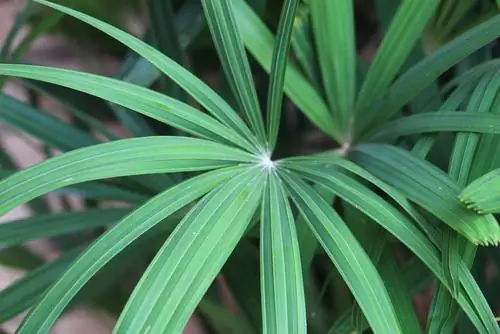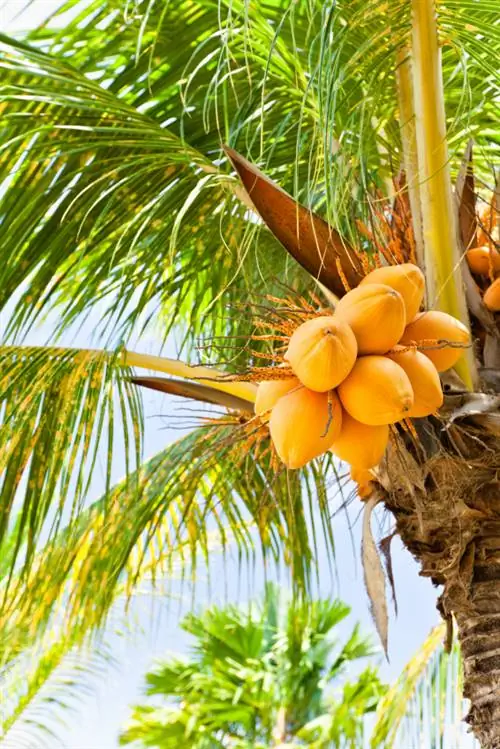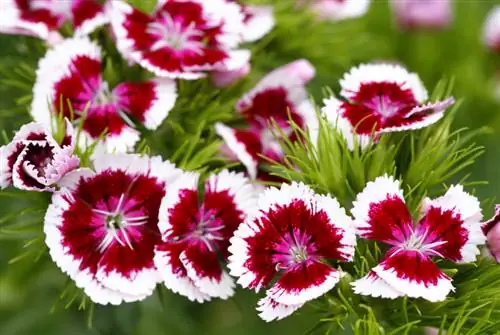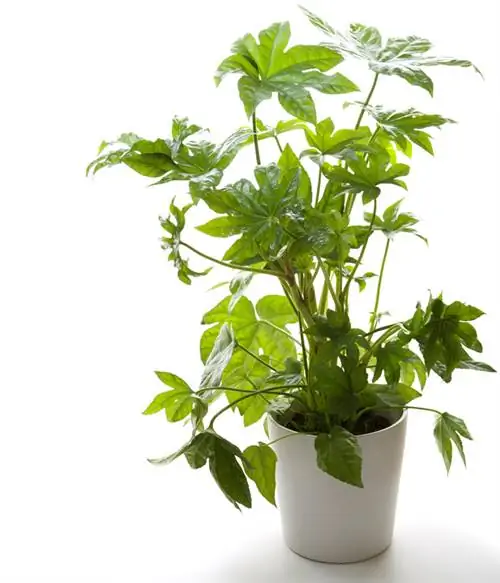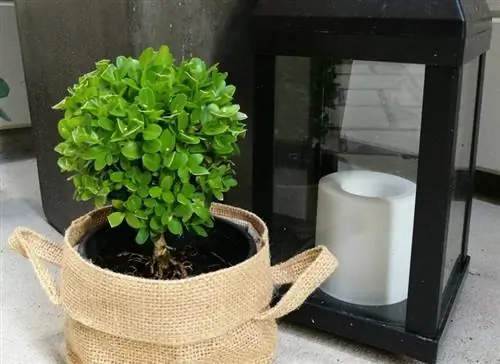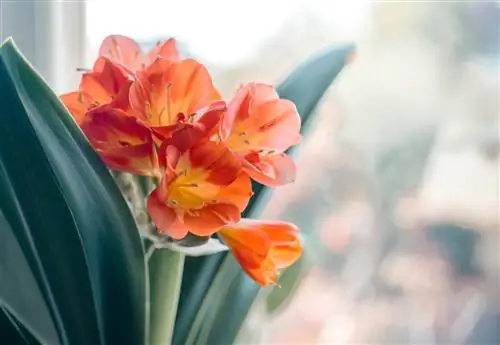- Author admin [email protected].
- Public 2023-12-16 16:46.
- Last modified 2025-01-23 11:21.
The stick palm (bot. Rhapis excelsa) is an extremely uncomplicated and shade-tolerant houseplant that has been cultivated in the living rooms of the German bourgeoisie since the end of the 19th century. To this day, the species, also known as umbrella palm or - in English - as lady palm, is one of the most popular indoor palms.
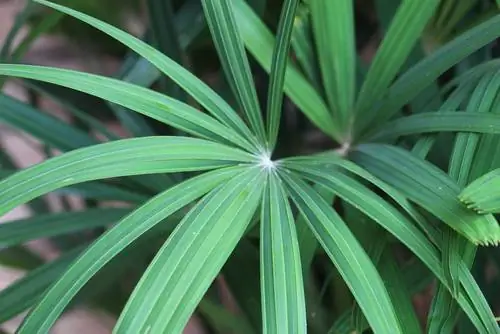
What are the optimal conditions for a floral palm?
The stick palm (Rhapis excelsa) is an easy-care, shade-tolerant houseplant that finds optimal conditions in partially shaded, protected locations. It prefers cool temperatures, moist environments and should be watered with low-lime water and fertilized regularly.
Origin and distribution
The stick palm is native to the south of the People's Republic of China, where it thrives in the undergrowth of evergreen tropical forests. Early on - more than 300 years ago - the species Rhapis excelsa came from China to the imperial court in Japan, where the vigorous and attractive plant quickly found great popularity and can still be found in many apartments and houses today. In contrast to the species represented here, there are numerous varieties in Southeast Asia, including some with variegated foliage. The stick palm only reached Germany in 1840 via England, where the palm plant was already cultivated in 1774 in Kew Gardens - the most comprehensive plant collection in the world at the time.
Usage
The floral palm is perfect as an indoor palm, but can also be kept as a potted plant on the balcony or terrace. The species Rhapis excelsa can tolerate short-term light frost, but should then be cleared away as quickly as possible. Overwintering outdoors is not possible. Rhapis excelsa feels just as comfortable in the living room as it does in the winter garden, in the stairwell or in the entrance area of the house.
Appearance and growth
The stick palm Rhapis excelsa is a relatively slow-growing umbrella palm, which also explains the comparatively high price for specimens with a height of 70 centimeters or more. In nature, the species reaches heights of up to five meters, but in pot culture it remains significantly smaller, with an average height of around two meters. The plant forms several thin, cane-like stems from the underground rhizome, giving it a bamboo-like, bushy appearance. For this reason the species is sometimes referred to as the bamboo palm. The lush green umbrella leaves are palmate and usually consist of five to eight segments. They arise directly from the trunks and sit on leaf stalks that are up to 30 centimeters long. The leaves taper to a point at the end and are somewhat reminiscent of needles.
Bloom and flowering time
The white to cream-colored flowers usually do not appear when grown in pots, as the plant must reach a certain minimum height - which, however, is not the case in the pot.
Toxicity
The floral palm is not poisonous to humans or animals and can therefore easily be placed as a houseplant in households with small children and/or pets.
Which location is suitable?
As a typical forest plant, the palm tree needs a semi-shady location protected from direct sun - after all, even in its natural location it is protected from the sun's rays by the tall trees and reacts accordingly to a place that is too bright with a yellow or yellow color. Browning of the leaves. A bright location - it should be at least 700 lux - but in a sunny location, for example in a corner of the living room, in the stairwell or in the winter garden, is ideal.
Temperature
The palm tree feels most comfortable in cooler temperatures between 15 and 20 degrees Celsius, which is why you can put it outdoors in a semi-shady place even in summer. The species Rhapis excelsa can tolerate frost down to around minus four degrees Celsius for short periods.
Humidity
Spraying the palm tree is not absolutely necessary, but regular moistening has clear advantages for plant he alth: pests such as spider mites have no chance at higher air humidity, especially during the heating period in winter. Shower Rhapis excelsa from time to time with the hand shower; this not only drives away leaf suckers, but also rinses the dust from the leaves.
Substrate
The stick palm feels most comfortable in a well-drained and slightly acidic compost-based substrate - peat soil is less suitable because this ingredient is not very permeable, not to mention the serious damage that is caused to the environment when it breaks down. Either use commercially available palm soil or mix compost soil with lava granules or expanded clay.
Planting / Repotting
It is best to move the palm tree into a larger pot and into fresh substrate immediately after purchase - in stores the plants are often in planters that are far too small and need space to grow. Choose a pot that is as wide as it is deep so that the rhizomes can spread and don't forget drainage! Waterlogging is absolutely fatal for the plant, which is why excess irrigation water must drain away quickly. Due to the slow growth, further repotting is only necessary every few years, although you can replace the used substrate about every one to two years. The best time for this is spring.
Watering the palm tree
Don't let the palm tree dry out, because it needs a substrate that is always well moistened for balanced growth - but it must not be wet. Always water the plant generously when the top layer of soil has dried slightly. Irrigation water leaking from the drain hole should be removed immediately. During the winter months, Rhapis excelsa needs less water than during the warm summer months - this is especially true if the plant is kept cool over the winter. Water the palm tree with low-lime water, as it - like so many exotic houseplants - has little lime tolerance. To do this, use collected, clean rainwater or filtered or well-stale tap water.
Fertilize the floral palm properly
During the main growing season between April and October, fertilize the palm tree about every two weeks with a liquid palm fertilizer (€7.00 on Amazon), which you administer together with the irrigation water. Alternatively, you can also use a slow-release fertilizer, such as granules or sticks. However, there is no fertilization in winter.
Cut the floral palm correctly
Pruning is neither necessary nor useful. However, you can carefully pick off dried, brown leaves - which is completely normal to a certain extent, because older leaves die off after a while.
Propagate floral palm
Small daughter plants often develop at the base of the palm tree, which you can carefully dig up in spring, separate from the mother plant and plant separately. The young plants should already be rooted at this point. Seeds are sometimes available in stores from which you can also grow your own plants.
Wintering
Although Rhapis excelsa can tolerate slightly sub-zero temperatures for a short time, if you are cultivating it outdoors in summer, you should still move the plant to its winter quarters in good time in the fall. As long as it is bright enough (at least 700 lux), cultivation in the living room or another room is possible, as the plant does not necessarily have to be kept cool. However, a bright overwintering at temperatures between ten and twelve degrees Celsius is ideal, as the palm tree takes a break from growth - and overwintering that is too light but warm makes it easily susceptible to diseases and pest infestation. During the winter months, water the plant less than in summer and do not fertilize at all between October and March.
Diseases and pests
Although the palm tree is generally very robust and rather insensitive to diseases and pests, it will quickly take offense at care mistakes. If the location is too dark (or too bright) and if care is not taken correctly, pests such as spider mites, scale insects and mealybugs will attack the palm tree plant. The animals usually hide at the base of the leaf fronds, but later often migrate to the leaves themselves.
It is completely normal for the lower leaves of the palm tree to gradually turn brown - as long as new green leaves continue to develop at the top. However, as soon as the leaves on top turn brown, you are probably watering the plant too much or too little. Yellow leaf fronds, on the other hand, indicate either a substrate that is too wet or too much direct sunlight. Brown leaf tips, on the other hand, indicate that the air in the room is too dry. You can carefully cut them off with pinking shears, but you should not cut into the he althy, green leaves - this would then continue to wilt. Instead, increase the humidity to avoid browning again.
Tip
Hollow palms are among the air-purifying plants that filter pollutants from the indoor air and instead have a positive effect on air humidity. By cultivating these (and other air-purifying plants) you can improve the indoor climate in your living room or bedroom.
Species and varieties
The species Rhapis excelsa, together with 10 other species, belongs to the genus of stick palms (bot. Rhapis), which are all native to Southeast Asia and are assigned to the palm family (Arecaceae). In addition to the species described in this article, the following representatives are also cultivated as houseplants.
Rhapis humilis
Rhapis humilis, with a height of around one meter, remains significantly smaller than Rhapis excelsa, and is also more delicate overall with its finely feathered leaf fronds and narrow trunks. This dwarf palm is therefore ideal for apartments that do not have enough space for a large palm tree. In terms of location and care, Rhapis humilis has the same requirements as the closely related Rhapis excelsa.
Rhapis subtilis
The species Rhapis subtilis also remains smaller when grown in pots than the better-known Rhapis excelsa, but can still reach heights of up to two and a half meters. Its trunks are very narrow with a diameter of up to 15 millimeters, but the plant appears very bushy due to the numerous palmate, dark green leaves. However, there is also an interesting variety with broad leaves that appears much more delicate. In contrast to Rhapis excelsa, which is quite cold-tolerant, Rhapis subtilis needs more warmth and needs to be watered more frequently. The species is still rare as a houseplant in this country, but is widespread in the USA.

